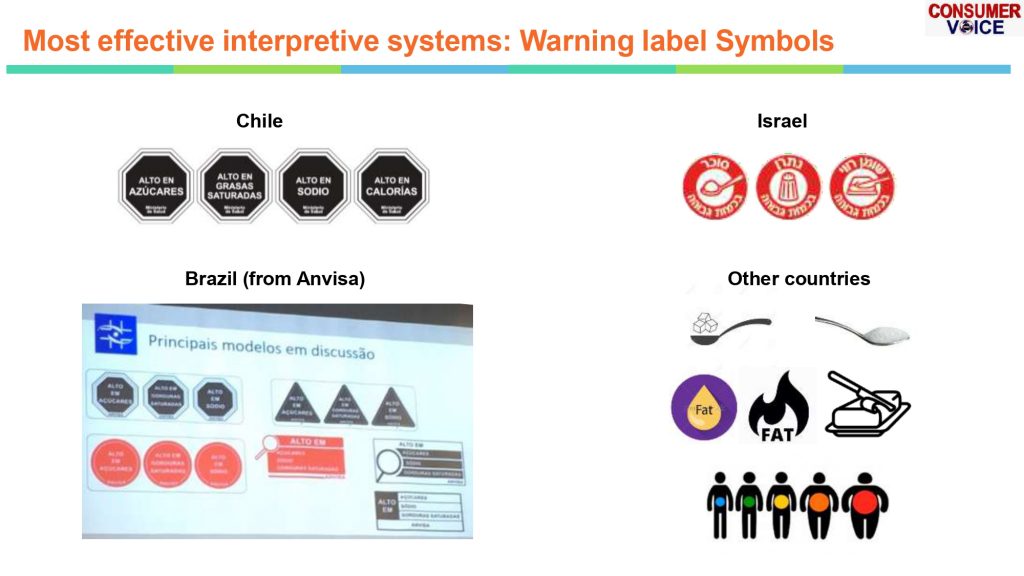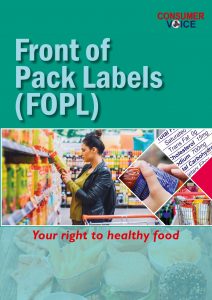Front-of-Pack Labelling

Front-of-Pack Labelling (FOPL) refers to the nutrition labeling systems present on the front side of the food packages. FOPLs are based on nutrient profiling models. These profiling These profiling models either consider the overall nutrition quality of the product or/the nutrients of concern associated with non-communicable diseases like diabetes, hypertension, heart diseases, etc. FOPLs often focus on presenting the nutrition information thoroughly and comprehensively.
Objective of FOPL
The objective of the FOPL policy is to inform consumers in a simple and fast way about the content of sugar, sodium and saturated fat & Trans fats to discourage the purchase of unhealthy packaged food. .
Why is there a need to regulate consumption of HFSS (High in Fat, Salt and Sugar) Foods?
Nearly 5.8 million people or 1 in 4 Indians are at a risk of dying from an NCD before they reach the age of 70. Disease burden of NCDs increased from 30% ‘disability-adjusted life years’ (DALYs) in 1990 to 55% in 2016, with deaths due to these conditions increasing from 37% in 1990 to 61% in 2016. Cardiovascular disease (CVD) accounts for at least 27% of NCD deaths. Untreated and uncontrolled hypertension contributes to an estimated 1.6 million deaths annually in India – 57% of these deaths related to stroke and 24% related to coronary heart disease. India is also fast becoming a diabetes and cancer hotspot.
This crisis is being further aggravated by the COVID-19 pandemic, as persons living with NCDs face a greater risk of becoming severely ill or dying from COVID-19. All of these conditions such as high blood pressure, high fasting blood sugar levels and obesity are closely linked to unhealthy diets, and an excessive intake of sugars, total fats, saturated fats, trans fats and sodium. In turn, the excessive intake of these “nutrients of public health concern”, is largely driven by the widespread availability, affordability and promotion of processed and ultra-processed food products with unhealthy nutritional profiles. Reports indicate that the COVID-19 pandemic generated a unique opportunity for the food and beverage industry to thrive in low- to middle-income countries and expand their market of unhealthy, ultra-processed foods and sugary drinks.
Dr Chandrakant Pandav, President, Indian Coalition for the Control of Iodine Deficiency Disorders (ICCIDD), warns that there is no time is to be lost. “It is clear as day that our food environment needs to change drastically if we are to reverse the health crisis and safe guard our future generations. Even as we move to fortify our food, it is equally critical to equip people with information regarding harmful nutrients in their food products including ie, high concentration of salt, sugar and fats, is an equally important strategy.”
With Front of Pack labelling, consumers can understand whether a food is specifically high in a nutrient, for example, protein or fiber, and compare it to other products as well.
Why FOPL
Research evidence suggests that FOPL makes nutrition information more accessible to consumers. Using the FOPL, consumers can make informed and healthy food choices. They can pick food items that are low in saturated and trans fats, sugar, and sodium. A strong front-of-package label is one of the most efficient tools of influencing consumer behaviour to alter dietary choices and reduce their vulnerability to NCDs. According to Dr Barry Popkin, the W. R. Kenan Junior distinguished professor of nutrition at the University of North Carolina Gillings School of Global Public Health sharing his experience from leading research on impact of FOPL in multiple countries said, “In our ongoing evaluations we have found that all countries which have adopted warning label system of FOPL that are easy to interpret, have succeeded in reducing consumption of the most unhealthy ultra-processed foods and beverages. As suggested by available evidence, this is one of the most effective approaches to preventing obesity and nutrition-related NCDs like diabetes and hypertension. People need to understand clearly and simply what is in the food that they are buying. Food labels have to interpret the nutrition information for consumers across age, income and literacy levels.”

Why are interpretive FOPL systems much more effective
WHO Guiding principles and framework manual for front-of-pack labeling for promoting healthy diets: “Briefly, interpretive FOPL systems that use interpretational aids and minimize numerical information are most useful for aiding consumer comprehension of FOPL information”
Report from the WHO Commission on Ending Childhood Obesity: “Recommendation 1.7: Implement interpretive front of-pack labeling supported by public education of both adults and children for nutrition literacy”
The UN Special Raporteur on the right to health: “Front-of-package warning labeling is a key measure for countries to tackle the burden of NCDs”.

India’s stand on FOPL
In 2018 the Food Safety Standards Authority India (FSSAI) published draft regulation for FOPL which was subsequently withdrawn for further deliberation. In 2020 December, FSSAI restarted the process of developing FOPL and has been in consultation with civil society, industry and nutrition experts for a viable model for India.
All about HFSS Foods, Hypertension & Food Labelling
Do you check the amount of salt present in the snack pack you pick from the store? This pack of snacks could be containing more than half of the amounts of salt you should consume in a day. Hence it is necessary to check the nutrition information on the food pack before buying. And mind the amounts of such food items accordingly as they could be high in fat, sugar, and sodium. Needless to say, their excessive consumption is often interlinked with the development of diseases like hypertension which could further progress into cardiovascular diseases. Read this article to know about HFSS (high in fat, salt, and sugar) foods, their association with non-communicable diseases, and how food labelling could aid consumers in choosing an apposite food item. Click here to read our expert’s view on this..
Proposed study on FOPL in India for Consumer perception
Objective of the Study:
- To compare the warning label, nutri-score labels, multiple traffic lights and GDA labels to no label in randomised control trial design in India.
- Preliminary formative research will first be undertaken to identify the best warning label for inclusion in the RCT
Primary outcomes:
- Lower intentions of purchasing a product high in salt, sugar or saturated or trans fat
- Perceived message effectiveness (extent to which the label makes participants worried about the health consequences of the product; makes the product unpleasant; discourages them from wanting to consume the product)
Role of Consumer VOICE
Consumer VOICE is playing an active role in advocating front of pack labelling in packaged foods to inform consumers on foods that are rich in fat, salt and sugar content and thereby regulating consumption of such foods. Consumer VOICE has represented consumer organisations in several meetings conducted by the regulatory body FSSAI for the same. It has also sensitised consumers through articles by experts both on the print and social media platforms.
VIDEOS
FOPL IN NEWS
⇨ Ensure It Is Healthy Millets In Your Platter
Jan 14, 2024 | Daily Pioneer
Millets belong to the family of cereals, but because of their coarse texture, they were often seen… Read More
⇨ Role of Civil Society in India’s battle against Hypertension
Dec 20, 2023 | Financial Express
Hypertension quietly affects over a billion people worldwide, presenting a significant risk… Read More
⇨ Fight lifestyle diseases with millets
Dec 18, 2023 | The Pioneer
India is facing the epidemiological transition with a spike in non-communicable diseases (NCDs)… Read More
EVENT UPDATES
Youth Sensitisation on Front of Pack Labels
Youth sensitisation workshop on Harmful effects of Packaged foods and Safeguarding health through...
The Unhealthy Side of Health Drinks
The recent sensation caused by a viral video featuring an influencer discussing the excessive...
FSSAI Draft Regulation on FOPL
On 13th September 2022, The Food Safety and Standards Authority of India (FSSAI) issued draft...





